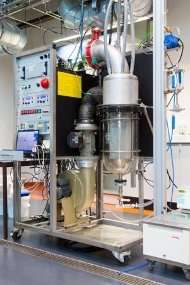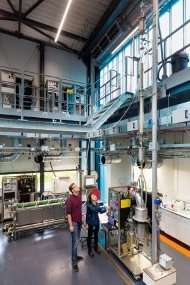Concentrated CO2 enables growth spurt in algae

A new technology captures CO2 from ambient air efficiently and inexpensively. Researchers at the University of Twente used the CO2 captured to cultivate algae, but the technology can also be used in a closed cycle to store energy harnessed from the sun and wind. Algae are a promising new raw material for the food and chemistry industries.
The 'CO2 air capture unit' is designed to capture a minimum of 500 grams of CO2 from the air per day and use it to produce microalgae. CO2 is present in the air in a very dilute form (approximately 400 ppm), so that around 1,400 cubic metres of air are needed to capture a kilo of CO2. Algae form a valuable raw material for food ingredients and for different chemicals in the bio-based economy. Their growth rate increases substantially under the influence of CO2. The new test set-up removes CO2 from the ambient air, not specifically from flue gases, with a capacity equivalent to four sizeable trees, each on 50 square metres of land.
The researchers use sorbents, pellets to which CO2 binds, for this purpose. In an 'adsorber', unloaded pellets are brought into contact with a large air stream that flows through the unit with a very low drop in pressure. When the pellets are loaded with CO2, they travel around six metres to the top of the unit. From there, they flow down again, by gravity, through a heated column, the 'desorber', releasing the CO2 they have captured in the process. Then the cycle begins all over again for the pellets.

The CO2-rich gas is subsequently transported from the air capture unit to the algae propagator. Although cooling and heating require energy, the net energy consumption is relatively low. The energy costs are therefore limited (they are estimated at approximately 75 euros for 1000 kg of CO2) and are comparable with current market prices. Besides being used for the cultivation of algae, this technology can also be used for glasshouse horticulture, for example. The use of 'CO2 air capture' will enable more sustainable CO2 production anywhere in the world, according to the Project Manager Dr Wim Brilman.
The CO2 captured can also be used for the storage of energy from the sun and wind, an issue that is perhaps the energy transition's greatest challenge. Methanol or sustainably-produced methane ('natural gas') for use in homes can be synthesized from hydrogen and CO2 from the air. Thanks to this intermediary step, fluctuations in energy supply and demand can be absorbed without having to use batteries. In the coming years, this 'natural gas route' will be tested in a 'Power-to-Gas' installation that is connected to an existing apartment complex in Rozenburg. In this application, central heating boiler emissions will no longer contain CO2 and solar and wind energy will be converted into natural gas. This is an attractive option for the energy transition, which is also simple to incorporate into the current infrastructure of the Dutch gas network, provided houses still have a gas connection. The expectation is, however, that natural gas in the home will soon be a thing of the past.
Provided by University of Twente




















